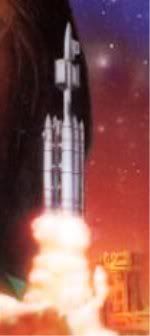If you could re-imagine the Phoenix, how would you do it?
Personally, I've thought about the Phoenix design from Star Trek First Contact and it doesn't really make a lot of sense.
For one it would seem a lot of early warp designs (XCV-330A, a number of Vulcan ships) had ring-shaped warp-engines. This actually makes a lot more sense as it's easier to project a bubble that surrounds the whole ship with a ring than with two nacelles.
Also, lauching it into space with a Titan rocket doesn't strike me as all that practical. For one the Titan isn't all that big a rocket, and second of all, it's not all that clear how the Phoenix managed to get it's crew back down to Earth.
I was thinking that I would have designed it with ring-shaped warp-engines. If launched into space with rockets, I'd be thinking of using a bunch of rockets (Look at the cover of "STAR TREK: The Eugenic Wars - The Rise And Fall Of Khan Noonien Singh Volume 2" by Greg Cox).
As for getting it back to earth, I was thinking some either the front of the ship able to seperate much like an old 1960's space-capsule, or the crew would dock with some kind of spaceplane like vehicle they would transfer to that and then land.
CuttingEdge100
Personally, I've thought about the Phoenix design from Star Trek First Contact and it doesn't really make a lot of sense.
For one it would seem a lot of early warp designs (XCV-330A, a number of Vulcan ships) had ring-shaped warp-engines. This actually makes a lot more sense as it's easier to project a bubble that surrounds the whole ship with a ring than with two nacelles.
Also, lauching it into space with a Titan rocket doesn't strike me as all that practical. For one the Titan isn't all that big a rocket, and second of all, it's not all that clear how the Phoenix managed to get it's crew back down to Earth.
I was thinking that I would have designed it with ring-shaped warp-engines. If launched into space with rockets, I'd be thinking of using a bunch of rockets (Look at the cover of "STAR TREK: The Eugenic Wars - The Rise And Fall Of Khan Noonien Singh Volume 2" by Greg Cox).
As for getting it back to earth, I was thinking some either the front of the ship able to seperate much like an old 1960's space-capsule, or the crew would dock with some kind of spaceplane like vehicle they would transfer to that and then land.
CuttingEdge100


